2014年 報告(2013年度プログラム)
2014年 海外短期フィールドワーク 児童発達学科 報告11-1
【2014年 海外短期フィールドワーク 児童発達学科 報告11-1】
■ Cabrillo College(アメリカ カリフォルニア州 サンタクルーズ) で、3/16〜4/1までの海外短期フィールドワークです。
■日付は、日本時間での表記です(現地は、1日前になります)。
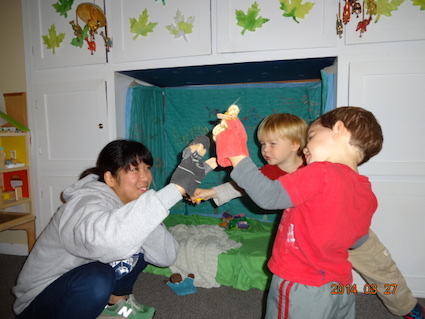
2014/03/27
今日から2日間は、4つの保育所に分かれて実習をします。朝、バスを乗り継いでそれぞれの実習先に行くだけでも大変なことでしたが、無事行きつきました! 学生がもっているパペットは忍者の格好をしていますね。2歳児はことばより表情や視線や行動でのコミュニケーション、いわゆる、ノンバーバルコミュニケーションが上手にできるでしょうか!
Today and tomorrow the students go to 4 different internship sites. Some have to take two buses to get to their schools, while some can walk to their schools from Cabrillo. So far I haven’t heard any problems, which is good! In this photo, she has a ninja puppet to play with other puppets. Communicating with two-year-olds needs lots of facial expressions, body movements, and eye gaze rather than words. I hope they are good at nonverbal communications.
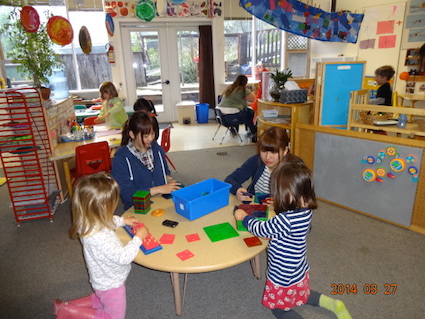
2014/03/27
一歳年上のこちらの部屋では、もうすっかりおしゃべりを楽しんでいました。そうなるとなかなか入っていけないのですが、このマグネットの使い方を教えてもらっているようです。
In this room for three-year-olds, children become verbal communicators. They enjoyed talking to their friends or to themselves. These children were trying to teach how to use magnetic building blocks to make a house. That’s what they thought they were!
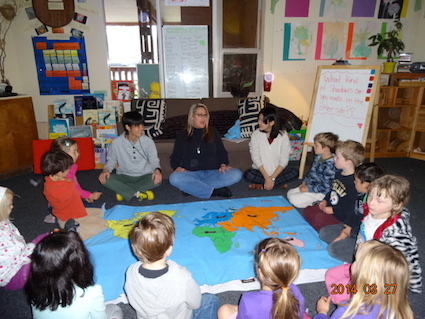
2014/03/27
こちらのこの保育所の一番上のクラスで、この秋からは小学校のKに行く子どもたちです。今月は宇宙がテーマになっていて、絵本読みも制作もジャーナルライティング(日記)もすべてが宇宙についてでした。ここでは、地球にはどれだけの大陸があるのかを聞いて、その後は日本はどこにあって、どうやってきたのかを聞かれていましたね。アメリカの地図では、日本はいつも右の一番はじにある小さな小さな国です! 世界の中の日本をいろいろな角度から見てみるのは面白いことですね。
This is a class for the oldest kids in this preschool. The theme in this room was the seven planets. Looking at the map of the earth, children were finding all the continents and their teacher asked them where Japan was and how the students came to Santa Cruz from Japan. In the world map here, Japan is located on the far right side of the map (and almost disappearing)! Japan is always located at the center of the map that we grew up with. It is interesting to realize that the world can be seen in so many different ways.
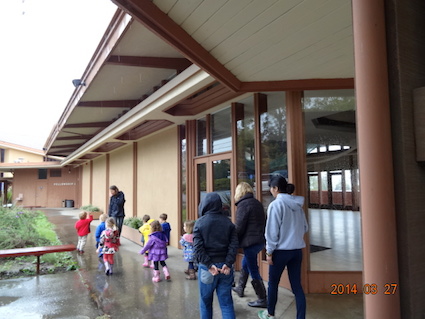
2014/03/27
今日は、こちらに来て初めの雨となりました。待望の雨でしたが、午後には晴れていました。雨の日は外遊びができないのではと思っていましたが、この2歳児のクラスでは、雨を感じるために長くつをはいてみんなで雨の中をこうやって歩きました。水たまりでバシャバシャやって、足跡がつくことを感じたり、雨粒を捕まえたり、その手を壁につけて自分の手形をつくったり、雨を楽しみながら歩く散歩にはたくさんの発見があったようです。学生たちは先生のこのような指導から何を学んだでしょうか。
It was raining today finally! We needed it but it cleared up this afternoon. A rainy day at school usually means that kids are kept inside but children in this class put their coats and rain boots on and walked in the rain. They were feeling the rain by jumping in puddles, making footprints, listening to and catching the rain. What did the students learn from this lesson?
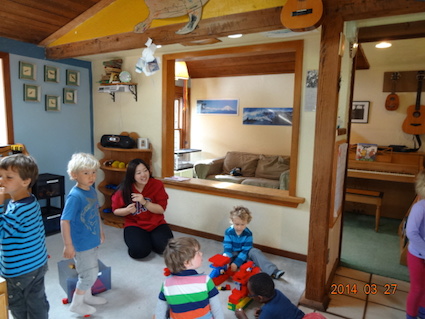
2014/03/27
こちらは、一軒家をそのまま保育所にしたところです。こじんまりしていますが、家全体が子どもたちのごっこ遊びに使えます。カブリヨ大学のChildren’s Centerの前のディレクターのジムと彼の奥さんが経営しています。
Jim and his wife turned their whole house into a daycare center. Children can play anywhere in the house and outside.
